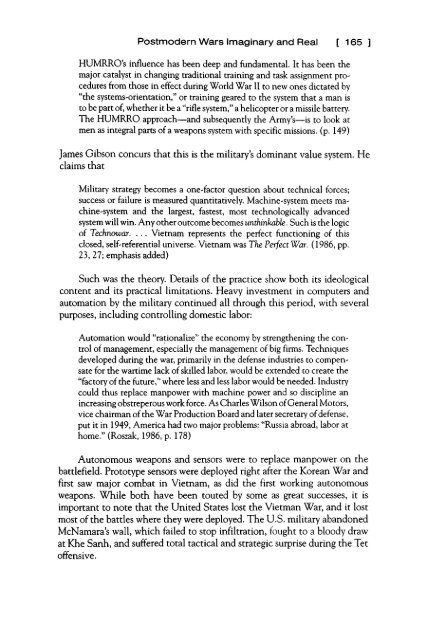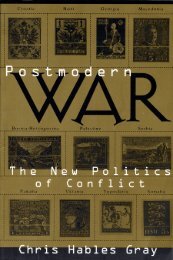Postmodern Wars Imaginary and Real: World War III - Chris Hables ...
Postmodern Wars Imaginary and Real: World War III - Chris Hables ...
Postmodern Wars Imaginary and Real: World War III - Chris Hables ...
You also want an ePaper? Increase the reach of your titles
YUMPU automatically turns print PDFs into web optimized ePapers that Google loves.
<strong>Postmodern</strong> <strong><strong>War</strong>s</strong> <strong>Imaginary</strong> <strong>and</strong> <strong>Real</strong> [ 165 ]<br />
HUMRRO's influence has been deep <strong>and</strong> fundamental. It has been the<br />
major catalyst in changing traditional training <strong>and</strong> task assignment procedures<br />
from those in effect during <strong>World</strong> <strong>War</strong> II to new ones dictated by<br />
"the systems-orientation," or training geared to the system that a man is<br />
to be part of, whether it be a "rifle system," a helicopter or a missile battery.<br />
The HUMRRO approach—<strong>and</strong> subsequently the Army's—is to look at<br />
men as integral parts of a weapons system with specific missions, (p. 149)<br />
James Gibson concurs that this is the military's dominant value system. He<br />
claims that<br />
Military strategy becomes a one-factor question about technical forces;<br />
success or failure is measured quantitatively. Machine-system meets machine-system<br />
<strong>and</strong> the largest, fastest, most technologically advanced<br />
system will win. Any other outcome becomes unthinkable. Such is the logic<br />
of Technowar. . . . Vietnam represents the perfect functioning of this<br />
closed, self-referential universe. Vietnam was The Perfect <strong>War</strong>. (1986, pp.<br />
23, 27; emphasis added)<br />
Such was the theory. Details of the practice show both its ideological<br />
content <strong>and</strong> its practical limitations. Heavy investment in computers <strong>and</strong><br />
automation by the military continued all through this period, with several<br />
purposes, including controlling domestic labor:<br />
Automation would "rationalize" the economy by strengthening the control<br />
of management, especially the management of big firms. Techniques<br />
developed during the war, primarily in the defense industries to compensate<br />
for the wartime lack of skilled labor, would be extended to create the<br />
"factory of the future," where less <strong>and</strong> less labor would be needed. Industry<br />
could thus replace manpower with machine power <strong>and</strong> so discipline an<br />
increasing obstreperous work force. As Charles Wilson of General Motors,<br />
vice chairman of the <strong>War</strong> Production Board <strong>and</strong> later secretary of defense,<br />
put it in 1949, America had two major problems: "Russia abroad, labor at<br />
home." (Roszak, 1986, p. 178)<br />
Autonomous weapons <strong>and</strong> sensors were to replace manpower on the<br />
battlefield. Prototype sensors were deployed right after the Korean <strong>War</strong> <strong>and</strong><br />
first saw major combat in Vietnam, as did the first working autonomous<br />
weapons. While both have been touted by some as great successes, it is<br />
important to note that the United States lost the Vietman <strong>War</strong>, <strong>and</strong> it lost<br />
most of the battles where they were deployed. The U.S. military ab<strong>and</strong>oned<br />
McNamara's wall, which failed to stop infiltration, fought to a bloody draw<br />
at Khe Sanh, <strong>and</strong> suffered total tactical <strong>and</strong> strategic surprise during the Tet<br />
offensive.








